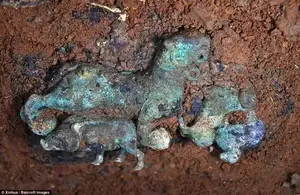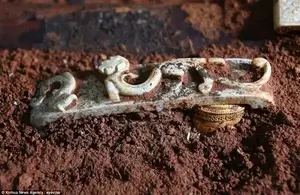A pullable small tiger, tiny gold ingots and a set of kitchen playsets made with bronze, these are the fascinating toys thought to be owned by the son of a Chinese emperor from more than 2,000 years ago.
Chinese archaeologists believe these findings were once played by Liu Chongguo, the eldest son of the controversial Chinese emperor Liu He during the West Han Dynasty (202BC-8AD), according to Xinhua News Agency.
Expert have also unearthed a metal seal belonging to Chongguo, who is believed to have died in his childhood.

The recently unearthed bronze containers (pictured) are believed to have been played by the son of a Chinese emperor

These bronze animal miniatures (pictured) are also thought to be the belonging of child whose father ruled West Han Dynasty

The tiny gold ingots, along with other treasures, were excavated in a massive imperial tomb complex in Jiangxi, China
The incredible relics, found in perfect conditions, were excavated from the tomb of Liu He in today's Jiangxi Province in eastern China.
Liu He (92BC-59BC) was one of the most short-lived emperors on the Chinese historyhaving ruled his kingdom for only 27 days.
Grandson of Emperor Wuwho was known as one of the greatest rulers of the Han DynastyLiu He was given the title 'Marquis of Haihun' after he was unseated as emperor, having only lasted a day shy of four weeks. He was dethroned by the royal faction for his lack of morals and talent.
The set of toys were found in the No. 5 tomb of Liu He's massive tomb complex.

Experts confirmed the identity of the owner of the tomb after finding this remarkable metal seal reading 'Liu Chongguo'

Jade, crystal and agate are also found together with the imperial seal in the tomb complex that occupies some 11.3 acres

Liu Chongguo's tomb was previously believed to be the tomb of Liu He's favourite mistress, but Liu Chongguo's seal and toys have helped experts identify him to be the tomb's owner. The child of Liu He passed away before reaching adulthood


Researchers believe that Liu Chongguo was the eldest son of the Liu He (pictured). Liu He was given the title 'Marquis of Haihun' after he was unseated as emperor, having only lasted 27 days. His tomb complex has been found in Jiangxi, China
Occupying 11.3 acres under the Guodun Mountain in Guanxi village, the grand imperial cemetery contained nine tombs, two main tombs and seven affiliated tombs.
Liu Chongguo's tomb was previously believed to be the tomb of Liu He's favourite mistress. But after unearthing his seal, experts announced the owner to be the Liu He's eldest son at a press conference on January 26.
Li Cunxin, a researcher with the Chinese Society of Social Sciences, said the seal was discovered along with jade, crystal and agate in the tomb. However, no remains of bones or teeth have been discovered as of yet.

While a number of treasures have been found in the No. 5 tomb inside Liu He's cemetery, only a few items have been found in the nearby No. 4 tomb, and the No. 6 tomb has not yet been excavated. There are a total of nine tombs in the entire complex

Chinese experts announced that the No. 5 tomb belonged to the son of Liu He at a press conference on January 26

Archaeologists examined the relics found in the 2,000-year-old tomb under the Guodun Mountain in Guanxi village, Jiangxi

Experts have declared the complex has the best preserved royal tombs of the Western Han Dynasty ever discovered in China
Yang Jun, head of the archaeological team, said only a few items have been found in the nearby No. 4 tomb, and the No. 6 tomb has not yet been excavated, since work started in 2011.
After a five-year study of the tombs, experts have declared them the best preserved royal tombs of the Western Han Dynasty ever discovered in China, said Xinhua.
The West Han Dynasty is the first part of Han Dynasty (206 BC- 25 AD).
The Han Dynasty was founded by Liu Bang, a commoner who became known as Emperor Gao Zu. It is said to be one of the most prosperous periods in China's history.

The relics unearthed in the impressive tomb believed to belong to the son of one of China's most controversial emperors

A copy photo shows the excavation site of the No. 5 tomb of the Marquis of Haihun site in east China's Jiangxi Province

Archaeologists believe these findings were once played by Liu Chongguo, the eldest son of the short-lived Chinese emperor

Li Cunxin, a researcher at the Chinese Society of Social Sciences, introduces the discoveries at a press conference on Friday